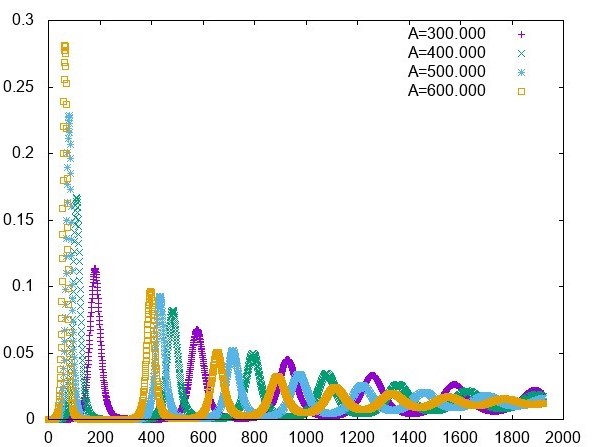Application of the SIR model in the study of dengue transmission in the municipality of Gurupi, Tocantins
DOI:
https://doi.org/10.20873/jbb.uft.cemaf.v7n1.rosaKeywords:
biomathematics, numerical methods, mathematical modeling, epidemiology, differential equationsAbstract
Dengue, an acute febrile infectious disease that can kill, has become one of the biggest public health problems in Brazil. Because it does not yet have an effective vaccine, its epidemiological profile multiplies throughout the national territory, especially in the summer, where the Aedes aegypti mosquito vector of transmission of the disease finds environmental conditions favorable to its high reproduction. The objective of this study is to discuss and apply the SIR model (susceptible, infected and recovered) in the description of dengue transmission in the municipality of Gurupi-TO. Carrying out simulations in order to validate the model comparing with the actual data of dengue cases in the municipality, besides presenting changes made in some parameters whose there are no records. Numerical simulations were carried out using a Runge-Kutta method of 4th order implemented in C language, using some parameters of the literature, others were adjusted for validation of the model for the periods of 2006/2011, 2009/2013 and 2014/2016, which provided a better fit for all periods when compared to actual data.
References
BASSANEZI, R.C. Ensino aprendizagem com modelagem matemática. São Paulo: Editora Contexto, 2002.
BRASIL, Ministério da Saúde. Portal da saúde. Disponível em: <http://portalsaude.saude.gov.br/index.php/o-ministerio/principal/secretarias/svs/dengue> Acesso em: 12 de Agosto de 2017.
BRASIL, Instituto Brasileiro de Geografia e Estatística. Con-tagem da População 2010. Disponível em: < http://cod.ibge.gov.br/2VXOL> Acesso em: 15 agosto 2017.
CÂMARA, F.P., THEOPHILO, R.L.G.; SANTOS, G.T.; PEREIRA, S.R.F.G.; CÂMARA, D.C.P. et al. Estudo re-trospectivo (histórico) da dengue no Brasil: características regionais e dinâmicas. Revista da Sociedade Brasileira de Medicina Tropical, v.40, n.2, p.192-196, 2007.
CRUZ, P.A.; ROSA, L.P.; CRUZ, L.C.C. A utilização de modelos matemáticos para análise de parâmetros populacio-nais da cidade de Gurupi. Revista Cereus, Gurupi-TO, v.8, n.1, p.33-45, 2016.
DE BARROS, A.M.R. Modelos matemáticos de equações diferenciais ordinárias aplicados à epidemiologia. Revista de Ciências Exatas e Tecnologia, v.2, n.2, p.62-67, 2015.
FREIRE, M.G.M.; DIAS, V.M.; NETO, A.F.S.; SANTOS; C.M.; SILVA, A.T.M.F. Zero Aedes: Fora Dengue, Fora Zika, Fora Chikungunya. Revista Perspectiva Online: Bio-lógicas & Saúde, v.7, n.24, p.23-31, 2017.
HEINZ, S. Mathematical modeling. New York: Springer, 2011.
KEATING, J. An investigation into the cyclical incidence of dengue fever. Elsevier, Social Science Medicine, n.53, p.1587-1597, 2001.
KERMACK, W.O.; McKENDRICK, A.G. A contribution to the mathematical theory of epidemics. Proceedings of the Royal Society of London. Series A, Containing Papers of a Mathematical and Physical Character, v.115, p.700-721, 1927.
PORTAL DA PREFEITURA MUNICIPAL DE GURUPI. História do município. Disponível em: <http://www.gurupi.to.gov.br/?page=dados-municipio>. Acesso em: 13 agosto de 2019.
ROCHA, D.I.C. Modelos matemáticos aplicados à epidemio-logia. 2012. 124f. Dissertação (Mestrado) - Curso de Méto-dos Quantitativos em Economia e Gestão, Matemática e In-formática - Faculdade de Economia Universidade do Porto.
SANTOS, D.A. Modelagem de Transmissão de dengue e problemas ambientais similares via sistemas de equações diferenciais ordinárias. 2013. 103f. Dissertação de Mestrado do Programa de Pós-Graduação em Ciências Ambientais da Universidade Estadual do Sudoeste da Bahia – UESB, Campus Itapetinga.
ZILL, D.G. Equações diferenciais. v.2, 3ª edição, São Paulo: Pearson Makron Books, 2001.

Published
How to Cite
Issue
Section
License
Copyright (c) 2024 - Journal of Biotechnology and Biodiversity

This work is licensed under a Creative Commons Attribution 4.0 International License.
Authors who publish with this journal agree to the following terms:
Authors retain copyright and grant the journal right of first publication with the work simultaneously licensed under a Creative Commons Attribution License (CC BY 4.0 at http://creativecommons.org/licenses/by/4.0/) that allows others to share the work with an acknowledgement of the work's authorship and initial publication in this journal.
Authors are able to enter into separate, additional contractual arrangements for the non-exclusive distribution of the journal's published version of the work (e.g., post it to an institutional repository or publish it in a book), with an acknowledgement of its initial publication in this journal.
Authors are permitted and encouraged to post their work online (e.g. in institutional repositories or on their website) prior to and during the submission process, as it can lead to productive exchanges, as well as earlier and greater citation of published work (Available at The Effect of Open Access, at http://opcit.eprints.org/oacitation-biblio.html).


